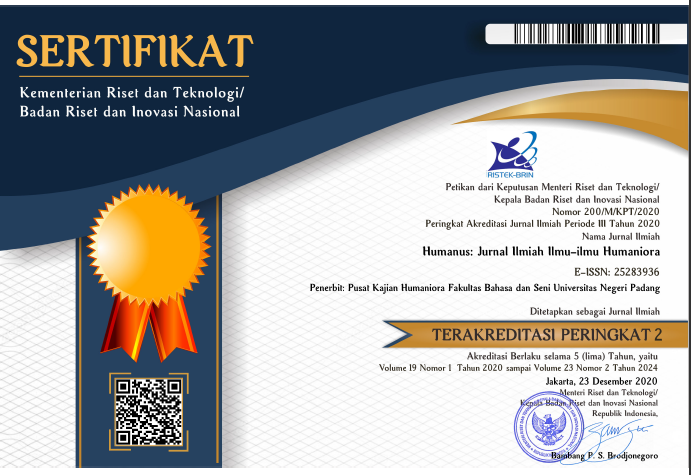Comparative Analysis of Chinese and Indonesian Vowel Systems
 ), Yusup Gumilar Sukma(2),
), Yusup Gumilar Sukma(2), (1) Wuhan University
(2) Wuhan University
 Corresponding Author
Corresponding Author
Copyright (c) 2020 Humanus
DOI : https://doi.org/10.24036/humanus.v19i1.108017
Full Text:
 Language : en
Language : en
Abstract
In Chinese and Indonesian languages, a syllable is composed of consonants and vowels. Many researchers have focused on studying consonants and paid less attention to vowels. However, vowels play an essential role in a syllable, which is in fact the most pronounced part of a syllable. It is because of vowels that people can perceive language and communicate with each other. This article takes the Chinese and Indonesian vowels as the research object and makes a comparative analysis of the Chinese and Indonesian vowel systems to reveal the similarities and differences between the two at the level of monophthongs, compound vowels, and allophones. Hopefully, it can make contributions to the development of the Chinese-Indonesian comparative phonology discipline. This paper mainly adopts qualitative research method, that is, combining literature integration method, description method, contrast method and analysis method. It reaches several conclusions: First, the Chinese monophthongs, compound vowels, and allophones are more developed than those of Indonesian; Second, there is contrast between rounded and unrounded lip sounds in the Chinese monophthong system, which does not exist in the Indonesian system; Third, there exists some cases in Chinese compound vowels system that the spelling is inconsistent with the actual pronunciation, but this is not the case in Indonesian. Fourth, Chinese vowels’ allophones are mainly caused by the different positions of vowel in the syllables, while in Indonesian they are mainly affected by the different natures of the syllables. The results of this research can provide some insights for other Chinese and Indonesian language researchers.
Keywords
References
Alwi, H., Dardjowidjojo, S., Lapoliwa, H., & Moeliono, A. M. (2010). Tata bahasa baku bahasa Indonesia (3rd ed.). Jakarta: Pusat Bahasa dan Balai Pustaka.
Anggreani, L. (2014). Compare analysis between Chinese and Indonesian phonetics and teaching suggestion. Humaniora, 5(1), 128-134. Retrieved from https://doi.org/10.21512/humaniora.v5i1.2991
Chaer, A. (2012). Linguistik Umum. Jakarta, Indonesia: Rineka Cipta.
Chaer, A. (2013). Fonologi bahasa Indonesia. Jakarta, Indonesia: Rineka Cipta.
Gao, H. M. (2005). The impact of Indonesian phonetics on standard Chinese phonetic learning. Overseas Chinese Education, (4), 29-34. Retrieved from https://doi.org/10.14095/j.cnki.oce.2005.04.005
Huang, B. R., & Liao, X. D. (2017). Modern Chinese (6th ed.). Beijing, China: Higher Education Press.
Ji, A. F., & Cai, A. J. (2013). Comparison of Indonesian and Chinese phonetics and analysis of difficulties in learning Chinese phonetics by Indonesian students. Overseas Chinese Education, (1), 79-87. Retrieved from https://doi.org/10.14095/j.cnki.oce.2013.01.014
Jiang, L. P. (2013). Modern Chinese phonetic training. Guangzhou, China: Jinan University Press.
Liang, Y. J. (2014). A contrastive study of Indonesian and Chinese phonetics (Master's thesis, Hunan Normal University, Changsha, China). Retrieved from http://www.hunnu.edu.cn/hnsd/
Lin, X. Y. (2010). Comparison of Chinese and Indonesian phoneme system and teaching strategies. In The 10th International Conference on Chinese Language Teaching (pp. 411-418). Shenyang, China: High Volume Publishing Company.
Lin, Y. T. (2006). Comparison of Indonesian Chinese phonetics and Chinese phonetic teaching (Master's thesis, Hebei Normal University, Shijiazhuang, China). Retrieved from http://www.hebtu.edu.cn/
Mao, S. Z. (2008). Teaching Chinese phonetic as a foreign language. Shanghai: East China Normal University Press.
Shao, J. M. (2010). Introduction to Modern Chinese (2nd ed.). Shanghai, China: Shanghai Education Press.
Tang, G. J. (2012). A comparison between Indonesian and Chinese phonetics. In Excerpts from Chinese Proficiency Test Training Handout of School of Chinese Language at Jinan University. Guangzhou, China: Jinan University Press.
Wang, M. L. (2011). An analysis of the pronunciation of the Chinese monophthongs of Indonesian and Korean students. TCSOL Studies, (4), 16-25. Retrieved from https://doi.org/10.16131/j.cnki.cn44-1669/g4.2011.04.003
Wang, M. L., & Sun, Y. Q. (2007). An analysis of Indonesian - Chinese students’ acquisition of Chinese triphthongs. Chinese Teaching in the World, (1), 89-98. Retrieved from https://doi.org/10.13724/j.cnki.ctiw.2007.01.013
Wang, Z. K., & Xie, W. Q. (1998). Linguistic course. Beijing, China: Foreign Language Teaching and Research Press.
Wikarti, A. R., Renata, E., & Moira, S. (2019). Contrastive analysis between Chinese and Indonesian phonology and implementation on conversation class. International Journal of Cultural and Art Studies, 3(1), 1-14. Retrieved from https://doi.org/10.32734/ijcas.v3i1.1390
Zhang, H. S. (2012). A study of classroom teaching method of Chinese as a foreign language. Beijing, China: The Commercial Press.
 Article Metrics
Article Metrics
 Abstract Views : 708 times
Abstract Views : 708 times
 PDF Downloaded : 196 times
PDF Downloaded : 196 times
Refbacks
- There are currently no refbacks.
Copyright (c) 2020 Humanus

This work is licensed under a Creative Commons Attribution-NonCommercial 4.0 International License.










